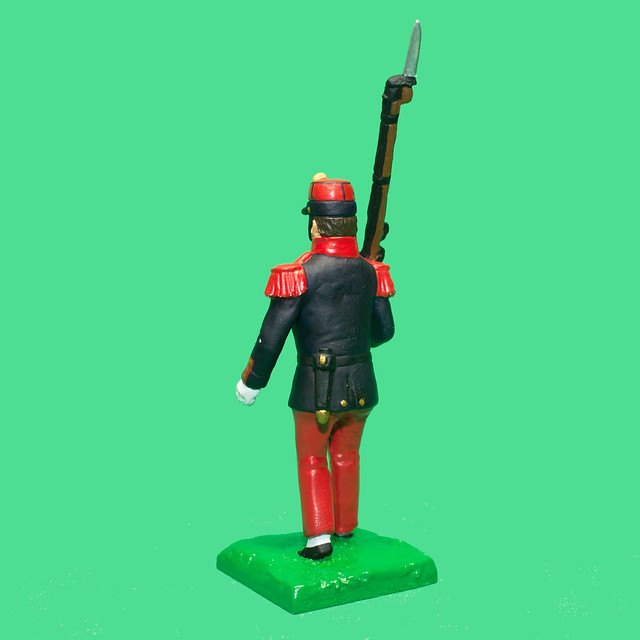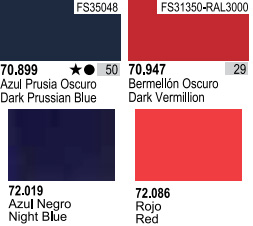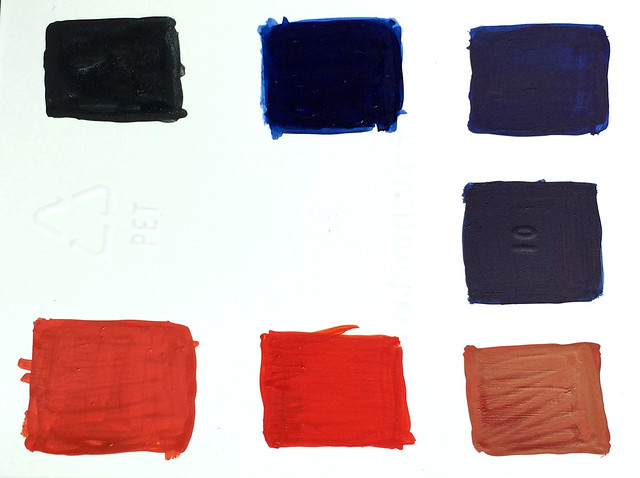Australia 35 - Scotland 34...If nothing else this result got me to pour my despondency into my painting! So much so that I actually completed my test painting of my Black Hat 54mm c. 1890 French Infantryman. Every cloud has a silver lining I suppose.
So here's the result (unvarnished)...
There are certain parts of my interpretation of the uniform that I am a bit unsure about - reference material of this exact period being somewhat scarce or ambiguous - but hopefully experts will find my soldier a spirited attempt.
Next I will give it a coat of varnish and then work on completing the construction of the rest of his regiment.
Postscript: About the rifle - The French rifle of the time should have been the Lebel Model 1886 rifle, which this 'toy' soldier clearly doesn't have. I suspect that Black Hat have produced a 'generic' model of a rifle which it uses for all it's late 19th century 54mm soldiers.
I think this model is based on a British Lee-Metford judging by the magazine. Perhaps I should have filed off the magazine and painted a fake receiver to make it look more like a Lebel?
Being the Ethereal Embassy for the Kingdom of Molatero and it's participation in the Funny Little Wars
Showing posts with label 54mm. Show all posts
Showing posts with label 54mm. Show all posts
Monday, 19 October 2015
Thursday, 15 October 2015
French 1905 uniform - colour tests
A bad case of the blues!
Time for a little break, I'm journeying west leaving the misty mountains of Molatero behind me and saying hello to the land of the Belle Époque as I start to plan the painting of my Black Hat French Infantry of the Line.
It took me some time to track down some pictorial reference for the French infantry uniform of the 1900 period, but eventually I came across a lovely lithograph (left). The trouble with lithograph reproductions is that the colour tints are a little 'washy' so they really don't give a true representation of actual colour intensity.
Take the blue of the tunic, for example. The artist's interpretation of the colour suggests that - overall - it is a mid-blue. This is due to the semi-transparent nature of the colour medium used and is also an artistic 'impression' of the colour to emphasis that the tunic is, indeed, blue.
So, while this illustration put me on the right track as far as the general colour scheme for the French uniform of time is concerned I was a little suspicious about the trueness of the colours. I'd much rather have some photographic reference to go by. And once again I got lucky as I came across a rather nice photo on good old Wikipedia...
"Cadets of Saint-Cyr wear in full dress (grande tenue) a special uniform, derived from the 1845 Regulations Infantry Officer Dress. This dress incorporates a dark-blue tunic, red trousers and a shako with red and white plumes. Facings are light blue, as is the képi worn on less formal occasions. Red fringed epaulettes are worn by cadets and yellow by cadet-officers. This traditional uniform was worn by both cadets and instructors at Saint-Cyr from 1845 until 1914 and then again from 1930 until 1939." Wikipedia
As you can see from the above photo the French tunic's 'blue' appears almost black and is very similar to the 'blue' of the British Police dress uniform in it's darkness. Neither is the red of the trousers a vidid red (nor a scarlet) but rather a subdued crimson (what the games paint ranges likes to call 'blood red'). It just goes to show that artists cannot be trusted! ;)
Vallejo paint equivalents
I had been rather enamoured by Tamiya acrylics because of their opaqueness, but they are rather difficult to work with. Vallejo acrylics are - I have found - a lot more user friendly and have a far wider range. I'd much rather work with a colour straight out of a bottle instead of mixing a colour, it makes it easy to replicate the same colour across numerous toy soldiers.
So I've been looking through the various Vallejo acrylic colour ranges to get the nearest equivalents to the photo reference I have. Unfortunately it look like I will have to bite the bullet and do some subtle mixing as the darkest Vallejo blues are still probably a bit light.
Colour and scale (and distance)
Ironically, after much consideration, I find myself considering taking a leaf out of the lithograph artists's book and tweaking the colour for 'effect'. The problem is one of scale and distance - that while Vallajo's 'Night Blue' might seem to be lighter than the blue Saint-Cyr cadet's tunics one must imagine the colour painted onto a 1/32 figure which will be mostly viewed from a distance of about 5 feet or so.
Skipping the dreary diatribe about colour theory (or am I too late) - the only way I will really get a sense of whether Vallejo's darkest blue 'fits' is actually to see it on a test figure. (And then to view that test figure at the desired distance.)
Left: Just in case I checked Humbrol's acrylic paint range too. I'm not a fan of Humbrol and in any case the closest blue they have is a gloss.
Should you really want to look into colour scaling theory then I recommend you click here: Cybermodeler Online's Scale Modeling Magazine Scale Effects in Modeling By Michael Benolkin.
So, the punchline is - if I paint my French soldiers with a the visually correct shade of midnight blue they will to all intents and purposes look like they are dressed in black tunics at arms length!
Suck it and see - my initial painting test
OK, enough talking - let's have a test. First things first, I apply a primer coat - matt white AutoKote...
Second job was to go out and buy the paints that I had chosen. As it turned out none of my local stores had them! (After all that!) So I ended up buying a small collection of what the shops did have...
Swatches
Top row: Dark Sea Blue, Imperial Blue, Dark Prussian Blue
Middle row: Dark Prussian Blue with addition of small amount of black.
Bottom row: Scarlet, Bloody Red, Flat Red.
Not perfect...I'm still going to have to do some mixing to get the 'midnight' blue I have in mind. The best mix seems to be the Vallejo Dark Prussian Blue with a dab of black in it. The crimson is a mix too, a 50/50 combination of Vallejo Bloody Red and their Flat Red.
The result...
Well, it looks like the blue and crimson in the 'Saint-Cyr' cadet photo above (I think), but the blue was tricky. I would still prefer to get the colour I want straight out the bottle as the idea of having to mix this deep blue consistently across 20 figures makes me nervous. (For some reason this mix seems to dry quite quickly so mixing up a large batch isn't feasible.)
The crimson was, however, a success and is really easy to replicate. (Phew!) My interpretation may look a little too vivid but that may be because of my cameras flash.
So, should I keep on looking for that perfect blue? I want to get this right and I'm in no hurry - my options are to investigate the Tamiya Royal Blue and also to see what Humbrol have to offer. Though straying from Vallejo means I have to order online and I like being able to pop down to my local model shop for stuff like this. (My town has just lost another model shop so it's becoming ever more important to shop in what local model stores we still do have!)
In the meantime I'll continue on with this test piece and finish it off - glossing may have a part to play in what I decide.
Time for a little break, I'm journeying west leaving the misty mountains of Molatero behind me and saying hello to the land of the Belle Époque as I start to plan the painting of my Black Hat French Infantry of the Line.
It took me some time to track down some pictorial reference for the French infantry uniform of the 1900 period, but eventually I came across a lovely lithograph (left). The trouble with lithograph reproductions is that the colour tints are a little 'washy' so they really don't give a true representation of actual colour intensity.
Take the blue of the tunic, for example. The artist's interpretation of the colour suggests that - overall - it is a mid-blue. This is due to the semi-transparent nature of the colour medium used and is also an artistic 'impression' of the colour to emphasis that the tunic is, indeed, blue.
So, while this illustration put me on the right track as far as the general colour scheme for the French uniform of time is concerned I was a little suspicious about the trueness of the colours. I'd much rather have some photographic reference to go by. And once again I got lucky as I came across a rather nice photo on good old Wikipedia...
 |
| The cadets of the Ecole Spéciale Militaire de Saint-Cyr, the French military academy, still wear the blue and red uniform of the French army before 1915. Source: Wikipedia (ironically, on an article on the colour 'blue'). |
"Cadets of Saint-Cyr wear in full dress (grande tenue) a special uniform, derived from the 1845 Regulations Infantry Officer Dress. This dress incorporates a dark-blue tunic, red trousers and a shako with red and white plumes. Facings are light blue, as is the képi worn on less formal occasions. Red fringed epaulettes are worn by cadets and yellow by cadet-officers. This traditional uniform was worn by both cadets and instructors at Saint-Cyr from 1845 until 1914 and then again from 1930 until 1939." Wikipedia
As you can see from the above photo the French tunic's 'blue' appears almost black and is very similar to the 'blue' of the British Police dress uniform in it's darkness. Neither is the red of the trousers a vidid red (nor a scarlet) but rather a subdued crimson (what the games paint ranges likes to call 'blood red'). It just goes to show that artists cannot be trusted! ;)
Vallejo paint equivalents
I had been rather enamoured by Tamiya acrylics because of their opaqueness, but they are rather difficult to work with. Vallejo acrylics are - I have found - a lot more user friendly and have a far wider range. I'd much rather work with a colour straight out of a bottle instead of mixing a colour, it makes it easy to replicate the same colour across numerous toy soldiers.
So I've been looking through the various Vallejo acrylic colour ranges to get the nearest equivalents to the photo reference I have. Unfortunately it look like I will have to bite the bullet and do some subtle mixing as the darkest Vallejo blues are still probably a bit light.
Colour and scale (and distance)
Ironically, after much consideration, I find myself considering taking a leaf out of the lithograph artists's book and tweaking the colour for 'effect'. The problem is one of scale and distance - that while Vallajo's 'Night Blue' might seem to be lighter than the blue Saint-Cyr cadet's tunics one must imagine the colour painted onto a 1/32 figure which will be mostly viewed from a distance of about 5 feet or so.
 |
| Magnificent old Britains French Field Artillery set. The photo at this scale gives the impression of very dark - almost black - tunics. |
Skipping the dreary diatribe about colour theory (or am I too late) - the only way I will really get a sense of whether Vallejo's darkest blue 'fits' is actually to see it on a test figure. (And then to view that test figure at the desired distance.)
Left: Just in case I checked Humbrol's acrylic paint range too. I'm not a fan of Humbrol and in any case the closest blue they have is a gloss.
Should you really want to look into colour scaling theory then I recommend you click here: Cybermodeler Online's Scale Modeling Magazine Scale Effects in Modeling By Michael Benolkin.
So, the punchline is - if I paint my French soldiers with a the visually correct shade of midnight blue they will to all intents and purposes look like they are dressed in black tunics at arms length!
Suck it and see - my initial painting test
OK, enough talking - let's have a test. First things first, I apply a primer coat - matt white AutoKote...
Second job was to go out and buy the paints that I had chosen. As it turned out none of my local stores had them! (After all that!) So I ended up buying a small collection of what the shops did have...
Swatches
Top row: Dark Sea Blue, Imperial Blue, Dark Prussian Blue
Middle row: Dark Prussian Blue with addition of small amount of black.
Bottom row: Scarlet, Bloody Red, Flat Red.
Not perfect...I'm still going to have to do some mixing to get the 'midnight' blue I have in mind. The best mix seems to be the Vallejo Dark Prussian Blue with a dab of black in it. The crimson is a mix too, a 50/50 combination of Vallejo Bloody Red and their Flat Red.
The result...
 |
| Still only partially painted, but the tunic and trousers are done. |
Well, it looks like the blue and crimson in the 'Saint-Cyr' cadet photo above (I think), but the blue was tricky. I would still prefer to get the colour I want straight out the bottle as the idea of having to mix this deep blue consistently across 20 figures makes me nervous. (For some reason this mix seems to dry quite quickly so mixing up a large batch isn't feasible.)
The crimson was, however, a success and is really easy to replicate. (Phew!) My interpretation may look a little too vivid but that may be because of my cameras flash.
 |
| 'Saint-Cyr' cadets again, be a nice future project to do a unit of these gentlemen! Source: Wikipedia. |
So, should I keep on looking for that perfect blue? I want to get this right and I'm in no hurry - my options are to investigate the Tamiya Royal Blue and also to see what Humbrol have to offer. Though straying from Vallejo means I have to order online and I like being able to pop down to my local model shop for stuff like this. (My town has just lost another model shop so it's becoming ever more important to shop in what local model stores we still do have!)
In the meantime I'll continue on with this test piece and finish it off - glossing may have a part to play in what I decide.
Thursday, 23 July 2015
Funny Little Recruits from TVAG
Usual apologies for the absence of blog entries, but I have actually been waiting for a rather special shipment to arrive from the colonies...[I have also been working on some scratch build projects which are occupying a lot of time.]
The Virtual Armchair General's 54mm/1:32 Resin Cast War Game & Collectible Figures First Range: Imperial Japanese Army & Navy, 1886-1911
I supposed we all must be aware of the excellent work that The Virtual Armchair General (TVAG) company does for the hobby, from the FLW Manual itself to paper props and other useful accessories. Well, they also make a line of 54mm plastic soldiers to accompany the Funny Little Wars hobby and they look so darn cute I have been tempted to get some for a while. Well...
As the cost of these unique little figures were so reasonable (especially when you compare them to some of the white metal equivalents available here in the UK) I couldn't resist ordering some samples just so I could evaluate them and write up a little review.
These charming characters are not kept in large volume by TVAG but are, to some extent, 'made to order'. I mention this because if you are in a hurry for a complete "Army Cerise" then I strongly advise you to check with TVAG about stocks first - patience is definitely a virtue, but as I go on to explain your perseverance will be well rewarded!
My order was a little random, I didn't really plan to make an Imperial Japanese army or unit (the only nation available at the moment) and so I simply chose whatever poses looked particularly interesting.
The material is a harder plastic (closer to scale model plastic than the traditional toy soldier soft plastic) which is rather nice. This makes the figures lighter and crisper in their moulding than white metal toy soldiers, but not as apt to warp or suffer from flash or 'bent gun syndrome' that is the bane of soft plastic figures.
The look of the figures and scale
These little chaps (and chapesses as it turns out) are very quaintly sculpted in a style that aficionados of H.G. Well's 'Funny Little Wars' will greatly appreciate. There is a smidgen of tongue in cheek about some of the poses and choice of characters, yet the Imperial Japanese uniforms are perfectly authentic - historically - but sculpted in a delightfully evocative Edwardian style. These are clearly toy soldiers and not miniature scale model soldiers (a fine distinction I know, but important).
One is immediately transported to the imaginary 'Funny Little Wars' world of Mr. Wells and I can imagine how splendid these sturdy little chaps look in formation on a carpet 'parade ground' or on a lawn 'battlefield'!
As to scale, the TVAG figures are on the shorter side of the 54mm-1/32 scale figure spectrum. I would say that they would fit in wonderfully well with the white metal figures of traditional 54mm figures of Dorset Soldiers or Irregular Miniatures, for example, but would be somewhat dwarfed by the modern 1/32 scale toy solders of Black Hat or Armies in Plastic.
[Note: I regularly use the terms '54mm' and '1/32' to differentiate the difference between the smaller slighter traditional figures and more sturdy and tall modern ones. As in real life toys soldiers seem to have grown slightly in height and girth over the years!]
In short, when one picks up a TVAG figure one immediately finds a smile adorning one's face. They are cheeky little chaps!
Range and use
As I already mentioned, TVAG only really do one comprehensive army range at the moment - Imperial Japanese Army & Navy, 1886-1911. Which is nice as not many toy soldier makers cover this theme (AiP do make some Japanese infantry for the Boxer Rebellion and Russo-Japanese War campaigns, but they do not make auxiliary or support personnel).
However, in supplying my order TVAG very kindly provided me with something of a teaser of things to come with the inclusion of a few 'bonus' figures (for which I am very, very grateful). Just take a look at these and I will be very surprised if you do not share my excitement over the possibilities of 'things to come'!
In use I can see these figures at the heart of some very economically priced FLW armies. The basic figure price is just $4.50 (£2.89) and TVAG do a four for three figure discount. This - of course - is no where as economical as making a regiment from soft plastic box sets by the likes of Armies in Plastic but you have to remember that you can chose the composition of your TVAG regiment so you can have a nice uniformly posed unit. (I have found that I have to buy at least two boxes of AiP sets - and sometimes even three - to get a regiment which is vaguely 'a set'.)
By comparison, Irregular Miniatures white metal 'Empire multi-part figures' can cost £4 each, while figures from their 'one-piece' ranges can cost £3.75.
Conclusion and assessment
Well, it's perhaps redundant to sum up my thoughts regarding these TVAG figures after my somewhat gushing description above! But just in case I was overly subtle - ! - I just wanted to conclude with a thoroughly positive recommendation.
Another aspect I really want to highlight about dealing with TVAG is the absolutely wonderful personal service which one receives from them. They exchanged several emails with me to appraise me of how long my figures would take and to ensure my order was correct. And so I'd like to thank them for their very friendly service.
Just remember to be a little patient (and do check about stock availability, especially if you want your soldiers in a particular base colour) and you will not - I assure you - be disappointed with these terrific little warriors.
Link: The Virtual Armchair General (USA) - 'Little Warriors'
The Virtual Armchair General's 54mm/1:32 Resin Cast War Game & Collectible Figures First Range: Imperial Japanese Army & Navy, 1886-1911
I supposed we all must be aware of the excellent work that The Virtual Armchair General (TVAG) company does for the hobby, from the FLW Manual itself to paper props and other useful accessories. Well, they also make a line of 54mm plastic soldiers to accompany the Funny Little Wars hobby and they look so darn cute I have been tempted to get some for a while. Well...
As the cost of these unique little figures were so reasonable (especially when you compare them to some of the white metal equivalents available here in the UK) I couldn't resist ordering some samples just so I could evaluate them and write up a little review.
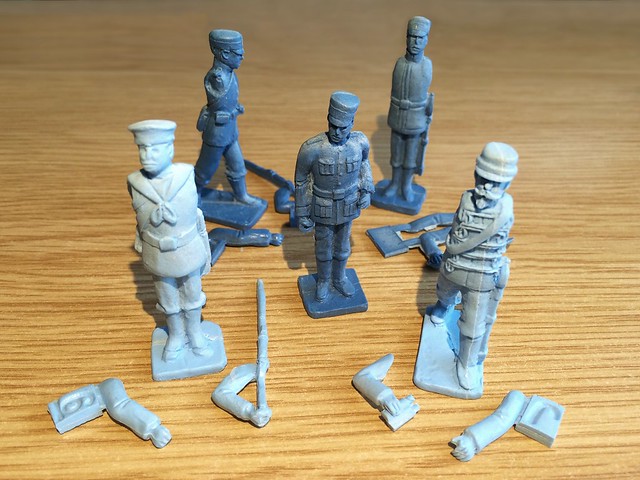 |
| A hotch-potch of Japanese soldiers (and a sailor). |
These charming characters are not kept in large volume by TVAG but are, to some extent, 'made to order'. I mention this because if you are in a hurry for a complete "Army Cerise" then I strongly advise you to check with TVAG about stocks first - patience is definitely a virtue, but as I go on to explain your perseverance will be well rewarded!
My order was a little random, I didn't really plan to make an Imperial Japanese army or unit (the only nation available at the moment) and so I simply chose whatever poses looked particularly interesting.
The material is a harder plastic (closer to scale model plastic than the traditional toy soldier soft plastic) which is rather nice. This makes the figures lighter and crisper in their moulding than white metal toy soldiers, but not as apt to warp or suffer from flash or 'bent gun syndrome' that is the bane of soft plastic figures.
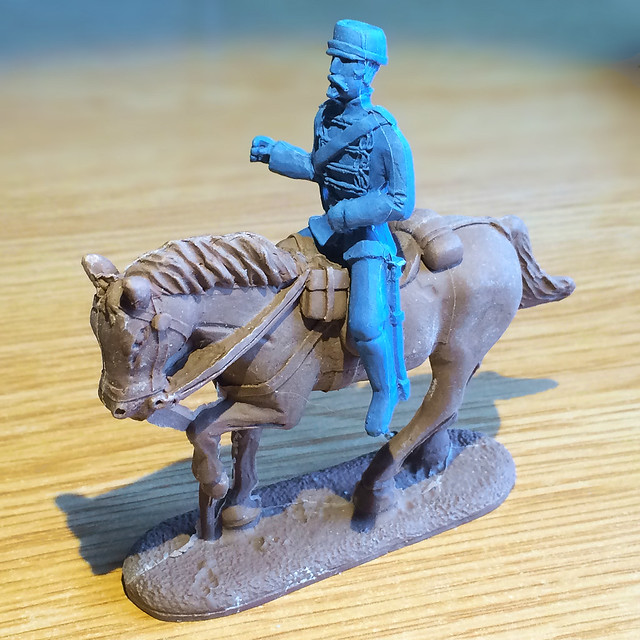 |
| Very impressed with the horses, looking forward to painting these. |
The look of the figures and scale
These little chaps (and chapesses as it turns out) are very quaintly sculpted in a style that aficionados of H.G. Well's 'Funny Little Wars' will greatly appreciate. There is a smidgen of tongue in cheek about some of the poses and choice of characters, yet the Imperial Japanese uniforms are perfectly authentic - historically - but sculpted in a delightfully evocative Edwardian style. These are clearly toy soldiers and not miniature scale model soldiers (a fine distinction I know, but important).
 |
| The sculpting is full of character and while some may find them 'cartoonish' I find them charming and well suited to the FLW philosophy. |
One is immediately transported to the imaginary 'Funny Little Wars' world of Mr. Wells and I can imagine how splendid these sturdy little chaps look in formation on a carpet 'parade ground' or on a lawn 'battlefield'!
As to scale, the TVAG figures are on the shorter side of the 54mm-1/32 scale figure spectrum. I would say that they would fit in wonderfully well with the white metal figures of traditional 54mm figures of Dorset Soldiers or Irregular Miniatures, for example, but would be somewhat dwarfed by the modern 1/32 scale toy solders of Black Hat or Armies in Plastic.
[Note: I regularly use the terms '54mm' and '1/32' to differentiate the difference between the smaller slighter traditional figures and more sturdy and tall modern ones. As in real life toys soldiers seem to have grown slightly in height and girth over the years!]
In short, when one picks up a TVAG figure one immediately finds a smile adorning one's face. They are cheeky little chaps!
Range and use
As I already mentioned, TVAG only really do one comprehensive army range at the moment - Imperial Japanese Army & Navy, 1886-1911. Which is nice as not many toy soldier makers cover this theme (AiP do make some Japanese infantry for the Boxer Rebellion and Russo-Japanese War campaigns, but they do not make auxiliary or support personnel).
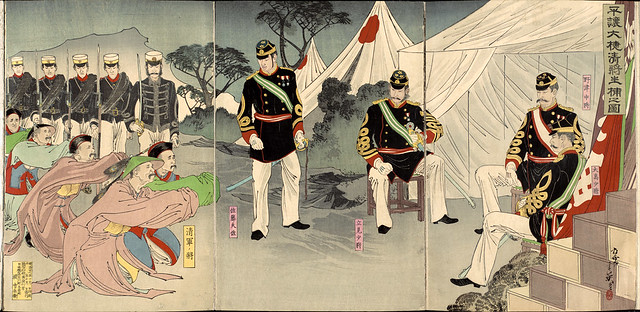 |
| An interesting contemporary illustration of Chinese generals in Pyongyang surrendering to the Japanese, October 1894. As you can see the Japanese of this period of military modernisation were greatly influenced by the uniforms of France and the United States. Source: Wikipedia. |
However, in supplying my order TVAG very kindly provided me with something of a teaser of things to come with the inclusion of a few 'bonus' figures (for which I am very, very grateful). Just take a look at these and I will be very surprised if you do not share my excitement over the possibilities of 'things to come'!
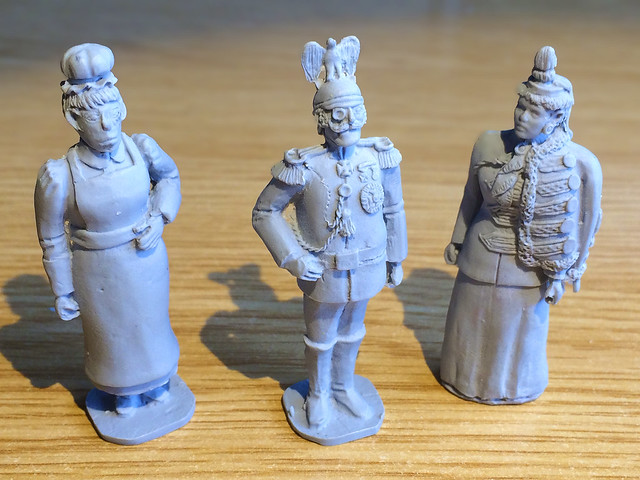 |
| My bonus models (thank you TVAG) are absolutely delightful! |
In use I can see these figures at the heart of some very economically priced FLW armies. The basic figure price is just $4.50 (£2.89) and TVAG do a four for three figure discount. This - of course - is no where as economical as making a regiment from soft plastic box sets by the likes of Armies in Plastic but you have to remember that you can chose the composition of your TVAG regiment so you can have a nice uniformly posed unit. (I have found that I have to buy at least two boxes of AiP sets - and sometimes even three - to get a regiment which is vaguely 'a set'.)
By comparison, Irregular Miniatures white metal 'Empire multi-part figures' can cost £4 each, while figures from their 'one-piece' ranges can cost £3.75.
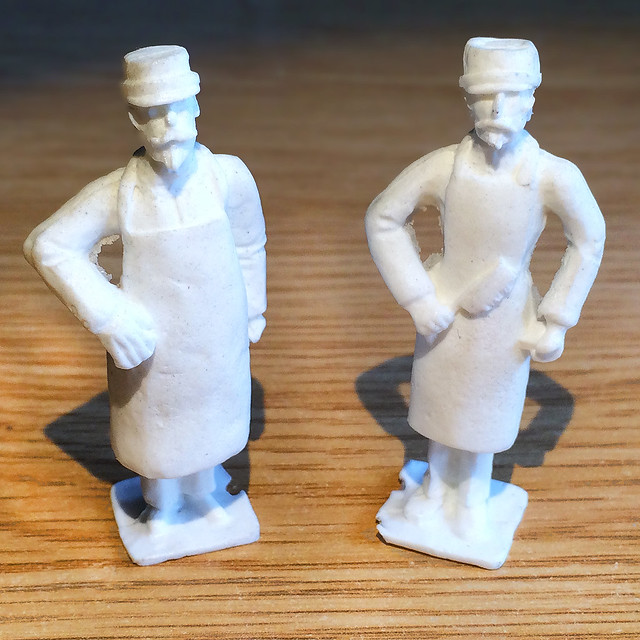 |
| The army's 'saw-bones'! Ready to give medical assistance (and probably a stiff Sake) to any casualties! |
Conclusion and assessment
Well, it's perhaps redundant to sum up my thoughts regarding these TVAG figures after my somewhat gushing description above! But just in case I was overly subtle - ! - I just wanted to conclude with a thoroughly positive recommendation.
Another aspect I really want to highlight about dealing with TVAG is the absolutely wonderful personal service which one receives from them. They exchanged several emails with me to appraise me of how long my figures would take and to ensure my order was correct. And so I'd like to thank them for their very friendly service.
Just remember to be a little patient (and do check about stock availability, especially if you want your soldiers in a particular base colour) and you will not - I assure you - be disappointed with these terrific little warriors.
Link: The Virtual Armchair General (USA) - 'Little Warriors'
Subscribe to:
Posts (Atom)


